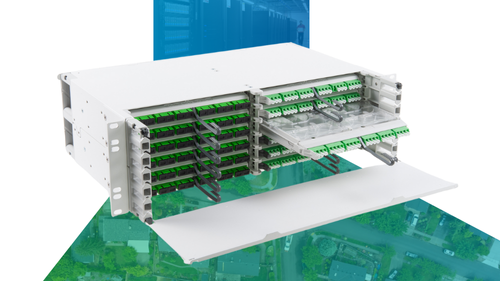CommScope recently expanded its HFC Access Network portfolio to include the industry’s first high-split digital return system. Together with our leading E6000 CCAP platform and family of Starline and Flex Max 1.2 GHz RF amplifiers, the high-split digital return completes an end-to-end DOCSIS 3.1 platform for addressing new demand for high-speed upstream data services.
We’ve seen a huge spike in operator interest around mid-split and high-split upstream technologies, especially in North America. The growing popularity of node splits was a highlight in the our recent earnings call. Several major operators have already been deploying mid-split HFC, which really doesn't require any new technology. But the 50% increase in upstream traffic that operators observed in the past year has inspired many to look beyond the mid-split and make their networks high-split ready. Our new high-split digital return gives operators the ability to take advantage of mid-split capabilities today, while leveraging existing assets and gaining the flexibility to upgrade to high-split with the flip of a switch when their networks and CPE are ready.
CLICK TO TWEET: CommScope’s John Caezza explains how the new high-split return addressed the new demand for high-speed upstream data services.
The high-split digital return is comprised of the CommScope DT4600N node transmitter and DR3600N headend receiver optics. It provides 204 MHz upstream capacity to meet growing demand for greater service group capacity and symmetrical data services to power the next wave of broadband services and gigabit network speeds. The solution gives operators the option to upgrade their existing headend and network optics with mid-split or deploy high-split-ready optics. Operators can then easily convert to high-splits later, when the current challenges surrounding high-split upstream performance—such as legacy set-top box support—are resolved.
While the high-split system can be implemented across various vendor hardware and architectures, it is simplest on the E6000 with UCAM-2—which represents nearly 50% of deployed E6000s—because of its support for full 204 MHz across all 24 ports. When implemented in this configuration, the high-split return can deliver data rates in excess of 1Gbps. DOCSIS 3.1 OFDMA support is available on R8.0 and later software releases and can be easily deployed via software licensing.
One of the overlooked advantages of the band-split approach to higher speeds is the way it cleanly addresses many operator pain points around network upgrades. Operators’ focus on downstream upgrades has required many node segmentations, which has driven hardware into the headend—as growing services groups demanded new CMTS ports, headend transmitters, receivers, muxes, etc. However, this approach put considerable strain on facility space, power, and capital associated with those expansions. While segmentation relieves contention, it does nothing to support increased upstream speeds—speed requires bandwidth.
Since 80-90% of node capacity segmentations today are driven by the upstream, it makes a lot of sense to simply increase the existing service group bandwidth, providing more capacity while enabling higher data rates without having to perform segmentations. The CommScope mid and high-split digital return enhances current network performance by leveraging existing assets in the headend and the field by simply increasing current service group bandwidths. Unlike node segmentation, mid- to high-split return technology doesn’t depend on the deployment of new headend and CMTS hardware to support new service groups created by node segmentation.
CommScope customers who deploy the E6000, CH3000 or CHP headend optics, and NC4000 or OM41x0 node optics can increase capacity and data rates by simply upgrading the amplifiers to mid-split, which requires no additional facility space and only incrementally more power. Moreover, the high-split solution allows customers to start with a mid-split today, and, when they are ready, light up the additional 120MHz of spectrum in the upstream along with the increased capacity and data speeds it provides.
Another major operator pain point that the solution addresses is capital spending. As broadband revenue growth slows, how do operators align capital allocation with revenue? Since the CommScope solution features the most widely deployed products in their category, the upgrade will be much more cost-effective.
If you’re an operator who has broadband networks using the E6000, CH3000, or CHP headend optics, and NC4000 or OM41x0 nodes, there really is no reason not be looking hard at the economics of this upgrade path to propel your broadband service offering for the next 7-10 years. The solution not only reduces the cost of providing network capacity and higher data rates, but it also facilitates new revenue development with premium services like symmetrical gigabit service and low-latency DOCSIS. Even if just one of these platforms is already place, the economics on a bits-per-hertz basis can be superior to the alternatives.
Key components of the enhanced end-to-end CommScope HFC Access Network portfolio include:
- The industry’s first high-split digital return system, supported by the DT4600N digital return transmitter and DR3600N digital return receiver
- The DT4600N and DR3600N support both 100 MHz and 204 MHz return bandwidths and are compatible with NC4 and OM4 series optical node platforms
- A full portfolio of modular DAA RxD solutions, which are also compatible with current NC and OM node platforms
- Sub-to, Mid-to high-split capable Starline and FlexMax 1.2 GHz amplifiers to power increased return bandwidths
- E6000 UCAM-2 DOCSIS 3.1 capable upstream line cards, which support a full 204 MHz bandwidth across all of the E6000’s 24 ports
- Nearly 50% of E6000 deployments are equipped with UCAM-2 line cards, making this option the simplest way to implement high-speed returns from the headend
- E6000 RX.X software, which supports DOCSIS 3.1 OFDMA
- The software is available as an individual license or through an enterprise offering
- Switched Digital Video and MPEG-4 solutions, which unlock the mid- to high-end portion of the return spectrum without impacting or reducing the number or quality of digital video services
For more information on the CommScope digital return and HFC Access Network portfolio, please contact your Account Representative or visit us at www.CommScope.com .














